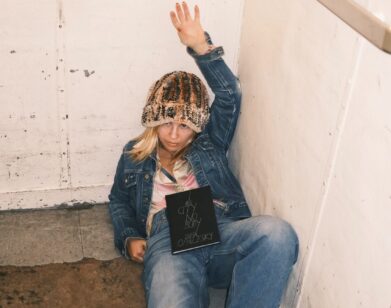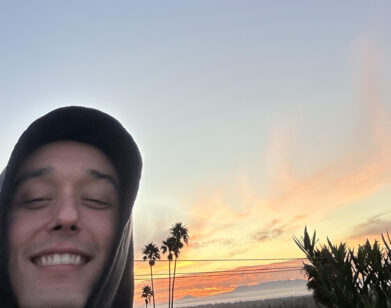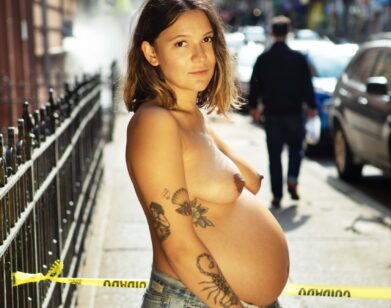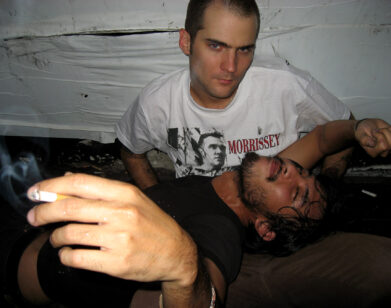How Henry Chalfant Captured the Striking Street Art of 1980s New York
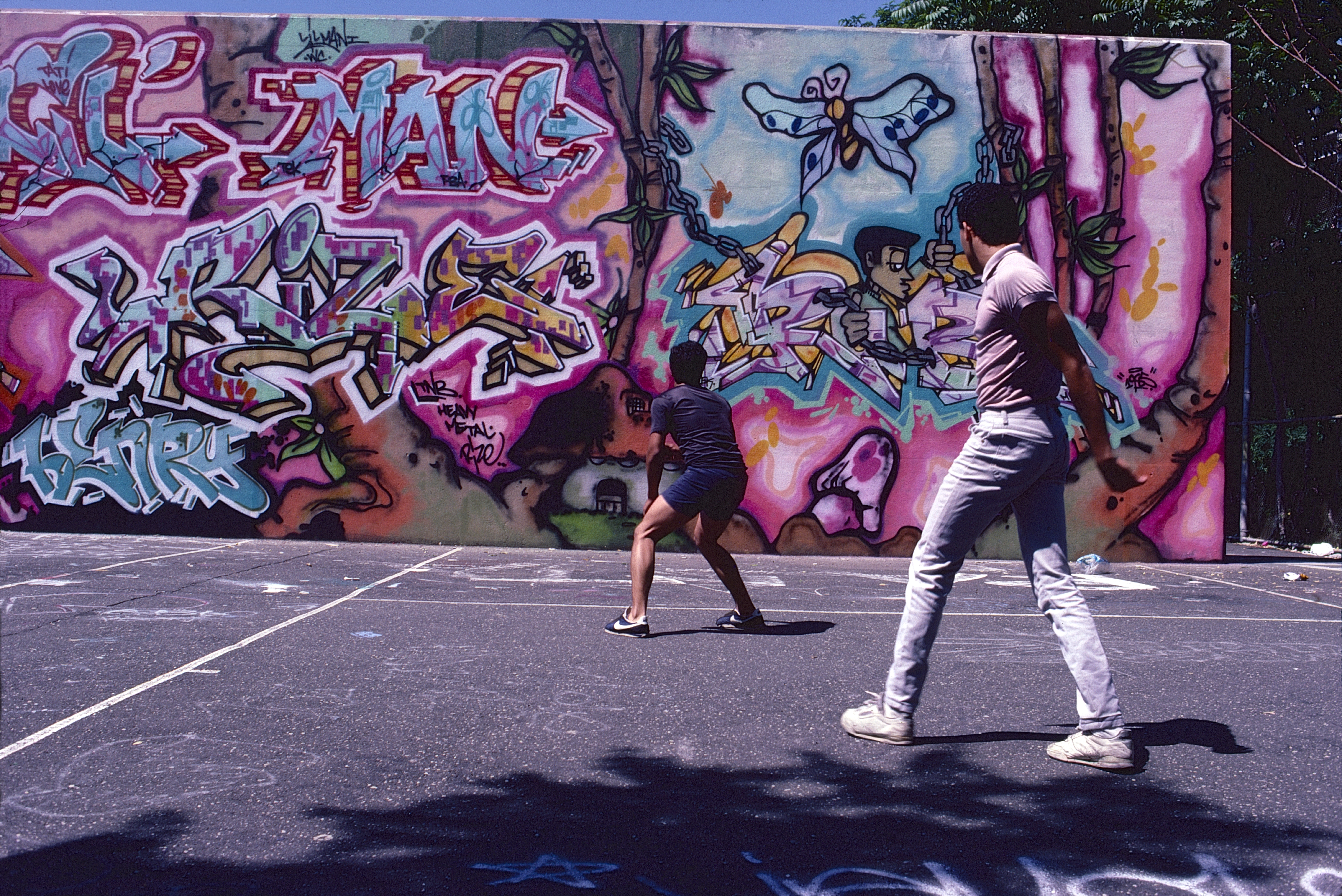
Henry Chalfant. Wall by Rize and Lil Man, Ven – Washington Heights, Manhattan, NYC, 1986. Courtesy Eric Firestone Gallery, New York.
The subways of New York City in the 1970s were part of a transit system much different than the one we have today, one running on malfunctioning cars, plagued by circuit failures, and decorated with some of the most striking graffiti in the history of street art. Photographer Henry Chalfant was one of the most thorough documentarians of New York City subway graffiti, compiling an archive of some 1,500 photos of subway art and hip-hop culture across the Bronx during his career. Much of it will be on view at the Bronx Museum of the Arts in the photographer’s first ever U.S. retrospective, Henry Chalfant: Arts vs. Transit, 1977-1987 from September 25th through March 8th, 2020. Alongside original images of the graffiti art, the exhibition also includes ephemera from the era, including a recreation of Chalfant’s studio and life-size train car prints. Before the opening, Interview sat down with Chalfant to hear what life was like shooting from train platforms, which stations were his favorite to visit, and how to avoid the cops.
———
MARK BURGER: What initially drew you initially to photograph the street art and the graffiti so thoroughly?
HENRY CHALFANT: I moved here in ’73 and it was exciting to see this rebellious, out of control stuff happening on the trains. I was curious about who was doing it, and I was watching it evolve and develop. I was only familiar with the tunnels and the stations underground, and I thought, “Oh, it’s too bad I can’t take really nice pictures of this because it would be fun to show my friends.” I had lived in other places before coming to New York, so I was kind of proud of my decision to come here and wanted to show off. That’s how it began–just for fun, and then the whole thing snowballed.
BURGER: Was there ever an instance where you thought, “Okay, this is a potentially dangerous situation to be photographing in”?
CHALFANT: Not at all. I felt quite comfortable wandering around the South Bronx in the ’70s. With the crack epidemic mid-’80s, things got a little dicey. I was in a gypsy cab on the street one day when we had to pull over and lie down in the car because there was a shootout going on on the street. That was a little scary. The other thing about the mid-’80s was that there were sniper shootings going on rooftops. Because I was an obvious figure standing on the platform for hours at a time, I began to feel nervous about that. But otherwise, and not to sensationalize it, but that’s when I kind of stopped–’85, I thought, “Meh, I don’t feel good.” Up until that point, I felt very comfortable and people were friendly and nobody bothered me. It was nice.

Henry Chalfant. Dust Sin, 1980. Courtesy Eric Firestone Gallery, New York.
BURGER: Out of all the photos in the exhibit, do you have a favorite? Or one, when you were shooting, that was a truly spectacular moment?
CHALFANT: I think the very first one I took. I took it in segments. There are four or five shots per car, and I then spliced them together after I got them developed. The first one happened because I was on a foray up to the Bronx. When I got up to around Prospect [Avenue], I saw all the trains that weren’t being used were parked in the middle track. I came across the “Merry Christmas” car. It was two cars, and it was a married couple. “Merry Christmas,” two double cars, painted by Lee, in between Prospect and Intervale Avenue, parked there. I thought, “Oh my god, I’ve got to get that. How am I going to do that?” So when I got to Intervale Avenue, I got off and I said, “I was just on this train, so there’s a good chance that it’s another five minutes before the next one comes along.” I ran down on the catwalk that borders the tracks, back in the middle where the cars were parked. Because I was even closer than from the other platform, the only way I could get it was snap, snap, snap, snap, take 10 pictures in segments.
I snapped the shots and then ran back to the platform and then went home, developed them, and spliced them together. It was very exciting to make those successfully, and it determined the rest of my time documenting how I would do it. Obviously not running out into the middle, but from the stations I was able to do it. At the beginning I thought, “Well, this is a dumb way to do it because you can’t ever get them really exact.” This is before digital splicing can get them correct. When you’re taking them on the fly, you can’t always be perfect, you know?
BURGER: What is it like to see, all these years later, the images back together in one place?
CHALFANT: It gives you a sense of the extent of these trains, because the system is huge and there were so many artists painting on them. I mean, I only got the tip of the iceberg. But just to give you a sense of what New York was like in those days, it was just festooned with these works of art everywhere you look when you were on the train line.

Henry Chalfant. Blade aka Blade Walking, 1980. Courtesy Eric Firestone Gallery, New York.
BURGER: That era of New York has a tendency to be romanticized. Do you feel like movies or television portray an accurate representation, or do you think it’s leaning too heavily into a rose-tinted glasses situation?
CHALFANT: There is definitely a nostalgia. I feel some of it myself. The city at that time in the ’70s was a very exciting place to be, because of all that was happening in the art and music scene around the city. It was relatively inexpensive to live here, and that world was concentrated and in a much narrower area in New York than it is now. Obviously, the romanticism is there because you forget the downside of it, which was a little scary. It was dangerous. There were lots and lots of muggings going on at gunpoint. There was a lot of hard drug use.
BURGER: What was the day-to-day like? Did you have any kind of routine?
CHALFANT: Well, I lived on the Upper West Side, so it was relatively close to the elevated lines in the Bronx. It was convenient for me to get up early, especially in the summer months when the light was long and early. I could get up and go to my favorite stations, which were Intervale Avenue and East Tremont, and catch whatever was on the 2 and 5 lines. Or, if I’d heard of something on the 1 line, I could go up to 125th Street really quickly. I would do that routinely, and then as I got to know artists, they would leave messages for me.

Henry Chalfant. KEL CRASH by Kel and Crash, on the 7th Avenue Express, 1980. Courtesy Eric Firestone Gallery, New York.
BURGER: Really?
CHALFANT: Yeah. I could pick up my messages from home. I had a machine in the studio. Remember the answering machines? I could find out over breakfast if somebody had done anything and on what line they’d done it and on what side of the train they’d done it. It would improve my chances of catching something, because it wasn’t like I caught everything. The system was random enough that you couldn’t actually count on being in the station when the train stopped on the other side with the masterpiece. You had to chase them. You had to go back over and over and try to catch them. And after rush hour, a whole bunch of trains were taken off and parked in the yards. Once rush hour was over, your chances of catching something were much reduced.
BURGER: I love that when the artists realized what you were doing, they would reach out to you.
CHALFANT: Yes, that was fun. It so increased my effectiveness, and of course they were happy to do it. They were happy for me to continue to document it, and I would share the photos with them. Probably people would say, “Yeah, but doing that, you encourage them to continue doing what they were doing,” said as a negative criticism. Who deserves the credit and who deserves the blame? I was deserving of both, I guess, depending on your point of view.
BURGER: It’s quite remarkable seeing how life just happens around it.
CHALFANT: Yeah, you go into the playgrounds, the kids are playing, and there’s this magnificent mural on the wall behind them. There’s one picture of people actually playing handball on the court, which is covered with graffiti. I can’t imagine how they played successfully because it would be really hard to see a ball coming at you out from that background. I heard about a piece in the Bronx on a Saturday, and I went up Sunday morning to catch it. It was on a handball court, and when I got there, there was a man with a bucket of white paint and a roller and he was going over all the pieces from the night before. He said, “I come out here every Sunday to play handball, and I’ve long since learned that I have to bring a bucket of paint and a roller if I’m going to do that because you can’t play with that stuff in front of you.”
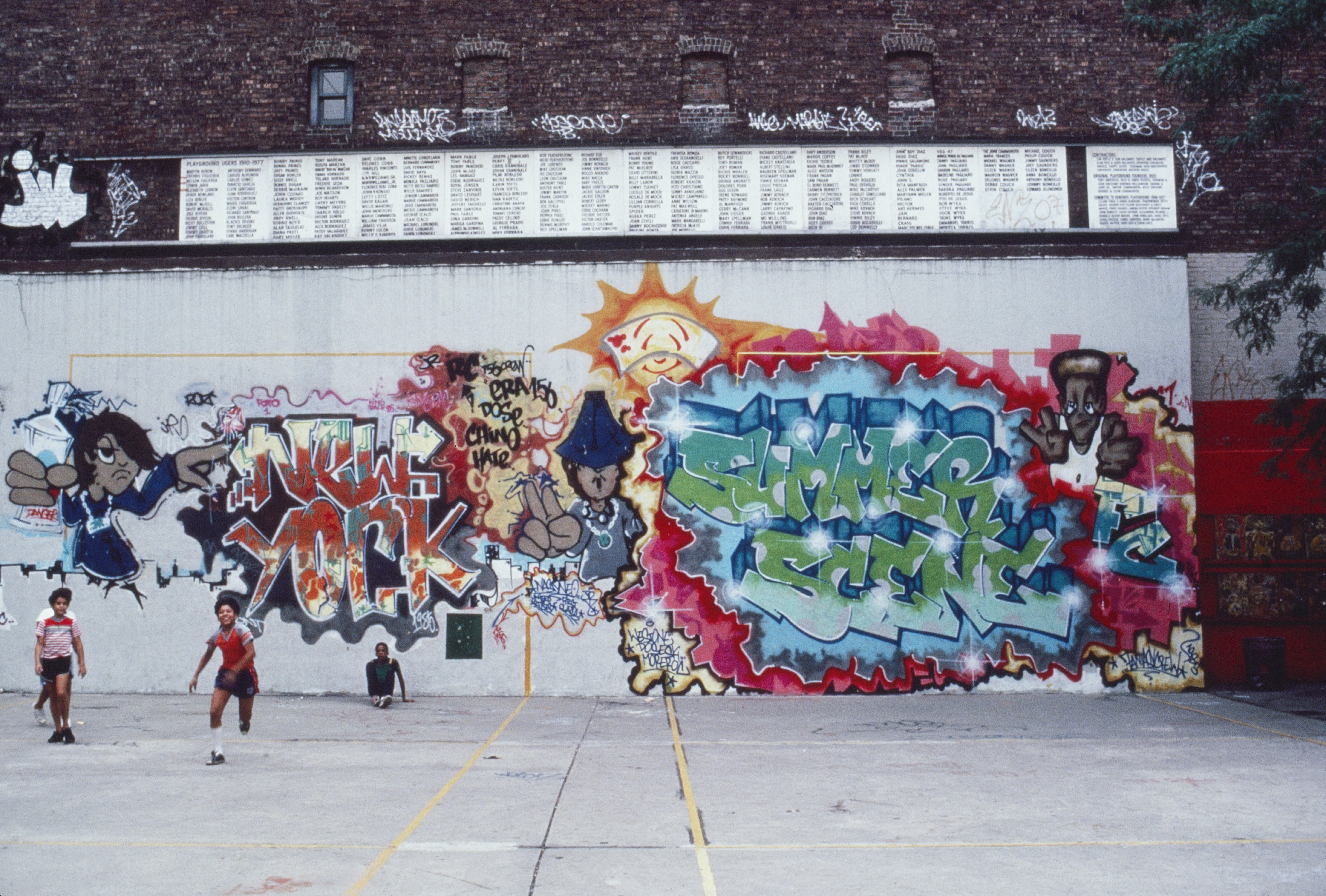
Henry Chalfant. Summer Scene by FC Crew, Manhattan, 1985. Courtesy Eric Firestone Gallery, New York.
BURGER: That’s commitment. Did anyone ever come up to you and question or confront you?
CHALFANT: A couple of times the police came to me and said, “You know, you can’t do this unless you have a permit.”
BURGER: Really?
CHALFANT: You’d have to get a permit from transit on Livingston Street in Brooklyn, and I wasn’t anywhere near there. You couldn’t get a blanket permit–you’d have to go and say you’re planning to go up on Friday, so you end up getting a permit for that one day. I didn’t do it. The first policeman stopped me, and I lied, of course. He said, “What are you doing?” And I said, “Well, it’s a school project I’m working on with my teachers and these are for blah, blah, blah.” And he said, “Okay, sir. Well, just so you know, you need a permit to do this.” And so I said, “Okay, thank you.” Then I wouldn’t go get the permit and I’d be terrified that I’d run the same cop again, but I’d never did. On one occasion, I was with some teenagers who were graffiti writers, and the cop was very hostile. He said, “You’re too old to be doing this.”
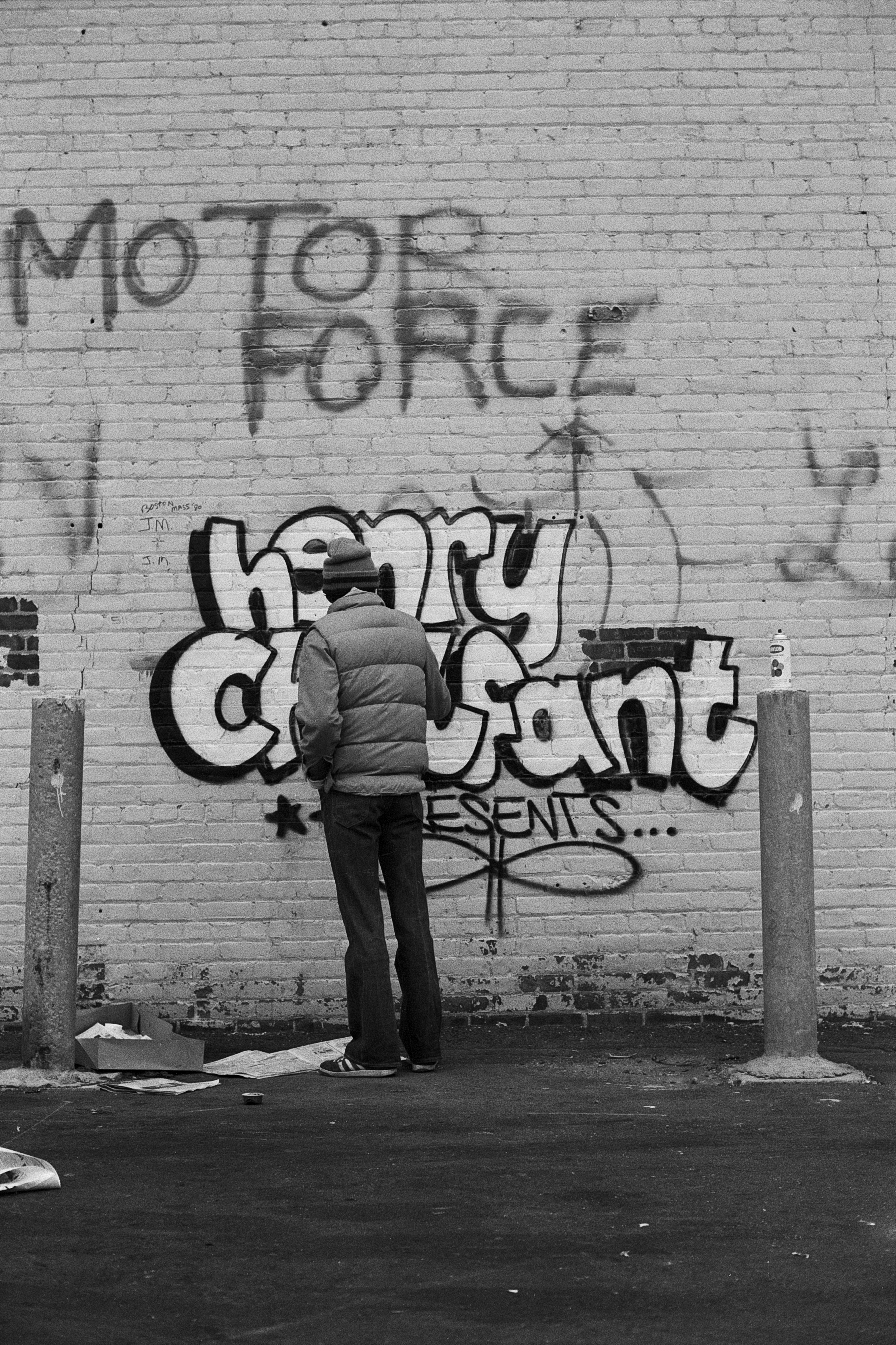
Henry Chalfant. Crash Paints “Henry Chalfant” on wall on the West Side of Manhattan and Canal St. 1980. Courtesy Eric Firestone Gallery, New York.


